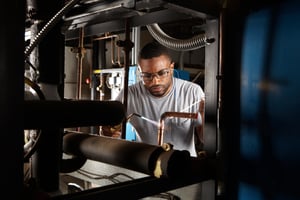
While safety is a critical component in any manufacturing operating, brazing carries its own hazards, including chemical fumes and the heat of the torch flame.
Modern safety programs focus on behavior-based safety (BBS) – encouraging employees to focus on actions leading to safer outcomes by preventing an injury or accident – rather than using only conformance-based approaches designed to penalize non-compliance or eliminate all risk. Ideally, you want to identify potential risks and then raise situational awareness, so that workers are cognizant of their immediate surroundings and the impact of their actions on their well being, as well as the safety of those nearby.
In addition to protecting individual workers, a robust safety initiative helps avoid lost-time injuries (LTI) for your operation and ensures that you meet – or exceed – OSHA requirements. Safe working conditions result in a safe day, safe tomorrow, safe years and safe careers.
Six Steps for Safe Brazing
Naturally, appropriate personal protection equipment (PPE) for a brazing job includes gloves to protect hands against heat and shaded goggles or fixed glass shields to protect operators against eye fatigue and vision damage. Next, take these well-tested steps in your workplace – and share these best practices with workers – to enhance brazing safety:
1. Ventilate confined areas. Brazing involves the possibility of dangerous fumes and gases rising from base metal coatings, zinc and cadmium-bearing filler metals, as well as fluorides in fluxes. Use ventilating fans and exhaust hoods to carry all fumes and gases away from work, along with air-supplied respirators as required.
2. Clean base metals thoroughly. Any surface contaminant of unknown composition on base metals may add to the fume hazard and may cause inadequate alloy bonding.
3. Apply sufficient flux. Flux protects base metals and the filler metal during the heating cycle. Proper flux coverage can help suppress outgassing of volatile elements in the braze filler or base metal. Consult the appropriate safety data sheet (SDS) for specific hazards associated with brazing flux.
4. Heat metals broadly. It’s important to heat the base metals broadly and uniformly. Why? Intense, localized heating consumes flux, increasing the danger of fuming. Apply heat only to the base metals, not to the filler metal, because direct heating of the filler metal causes overheating and fuming.
5. Know your base metals. A cadmium coating on a base metal volatilizes and produces toxic fumes during heating. Zinc coatings (galvanized) also fume when heated. Outgassing of these elements not only presents a safety hazard, but can lead to increased porosity in your braze joint. Be sure to check that your base metals do not have these coatings prior to brazing.
6. Know your filler metals. Be especially careful not to overheat an assembly when using filler metals that contain cadmium. Consult the material’s SDS for maximum recommended brazing temperatures of a specific filler metal. Each filler metal carries a warning label; look for it and follow the instructions carefully.
Ensuring safety in your brazing practice pays off in the well being of your employees as well as the success of your operation. If you need assistance, consider a brazing audit from the Lucas Milhaupt Technical Service team. Our experts can conduct a thorough technical audit of your brazing process and provide a report of process improvement recommendations.
Additional Resources
Lucas Milhaupt Safety Data Sheets provide explicit instructions for safe and effective application.
For more safety considerations, see the American National Standard Z49.1, "Safety in Welding and Cutting," published by the American Welding Society (AWS).
